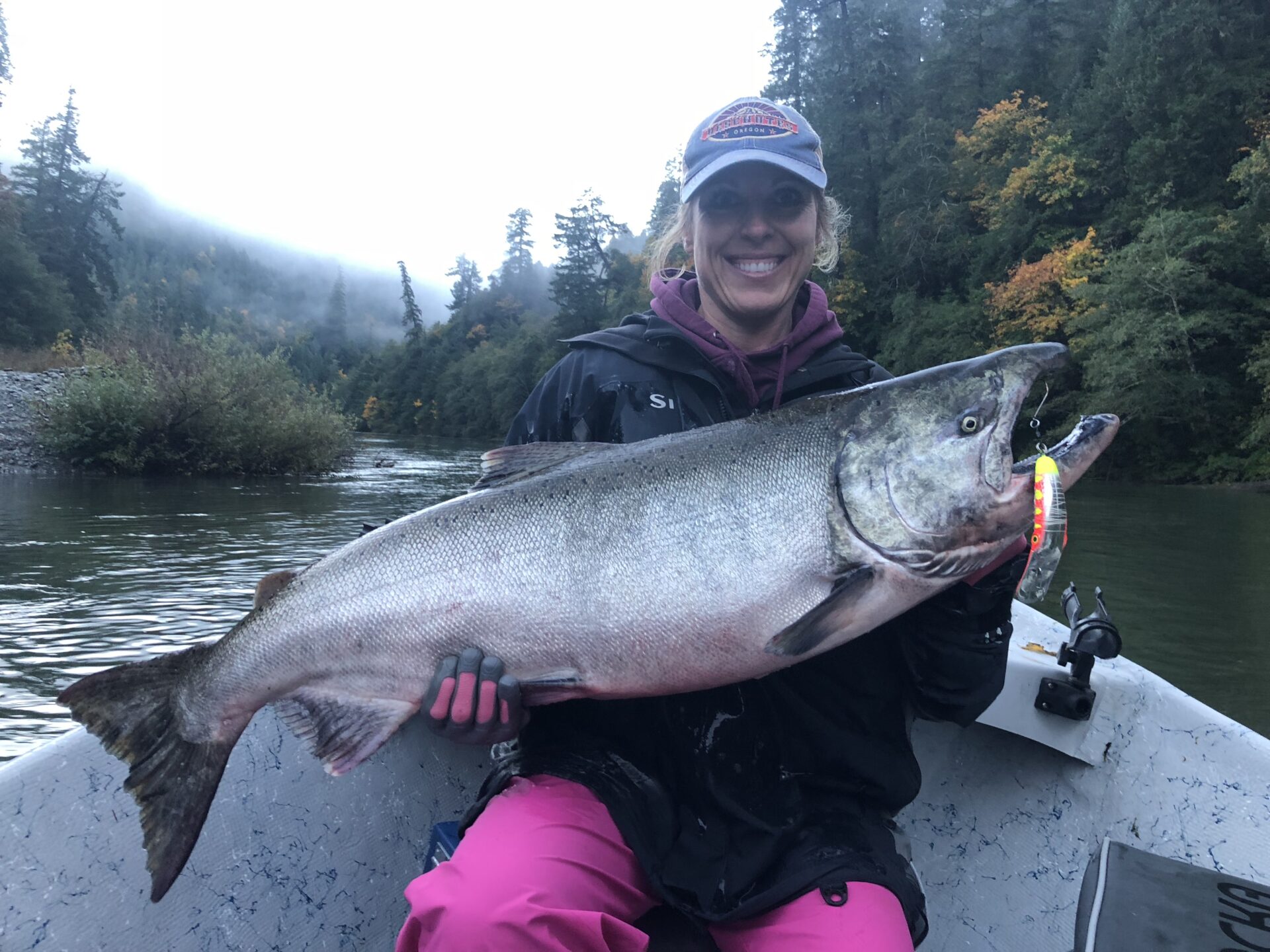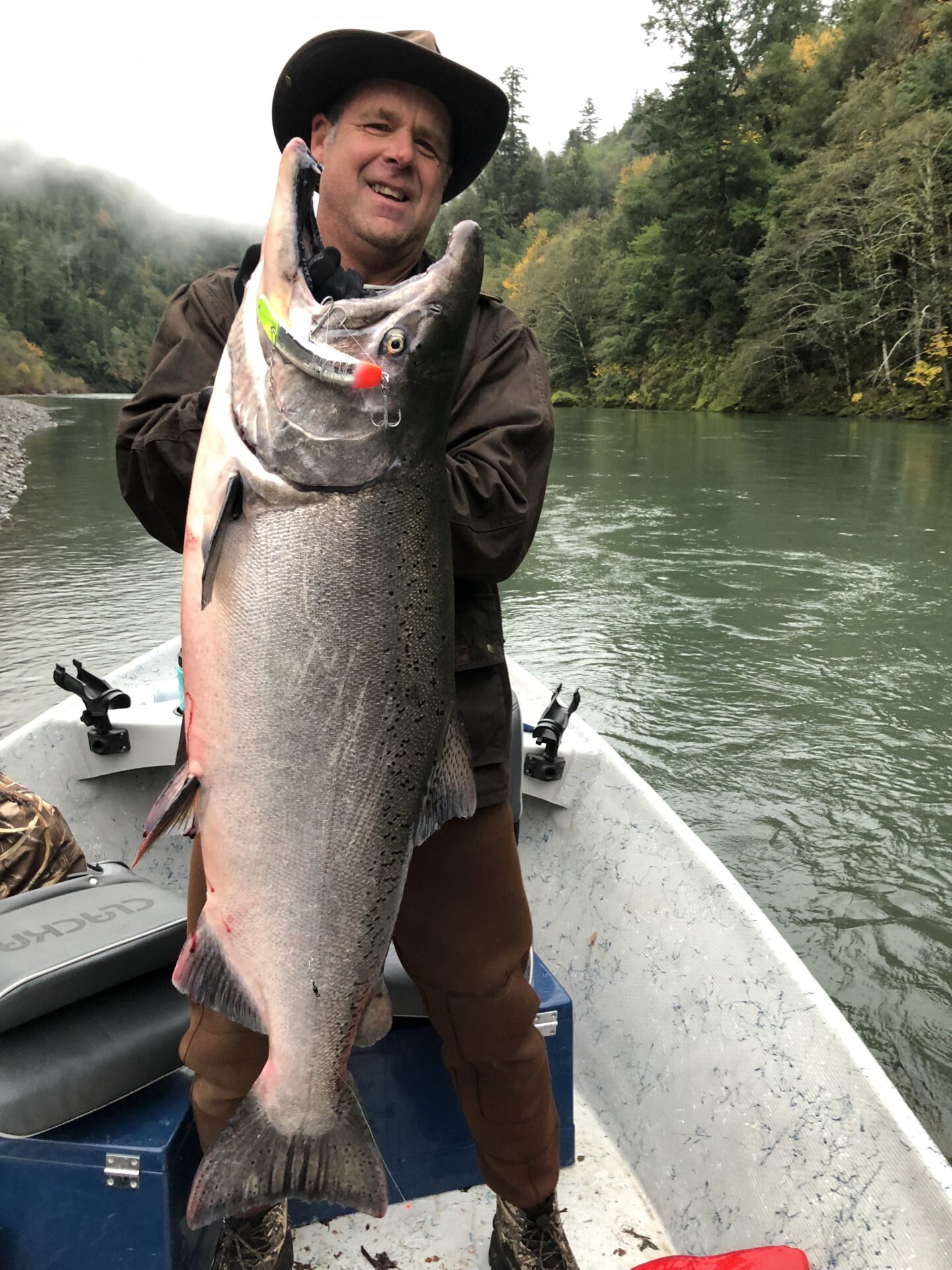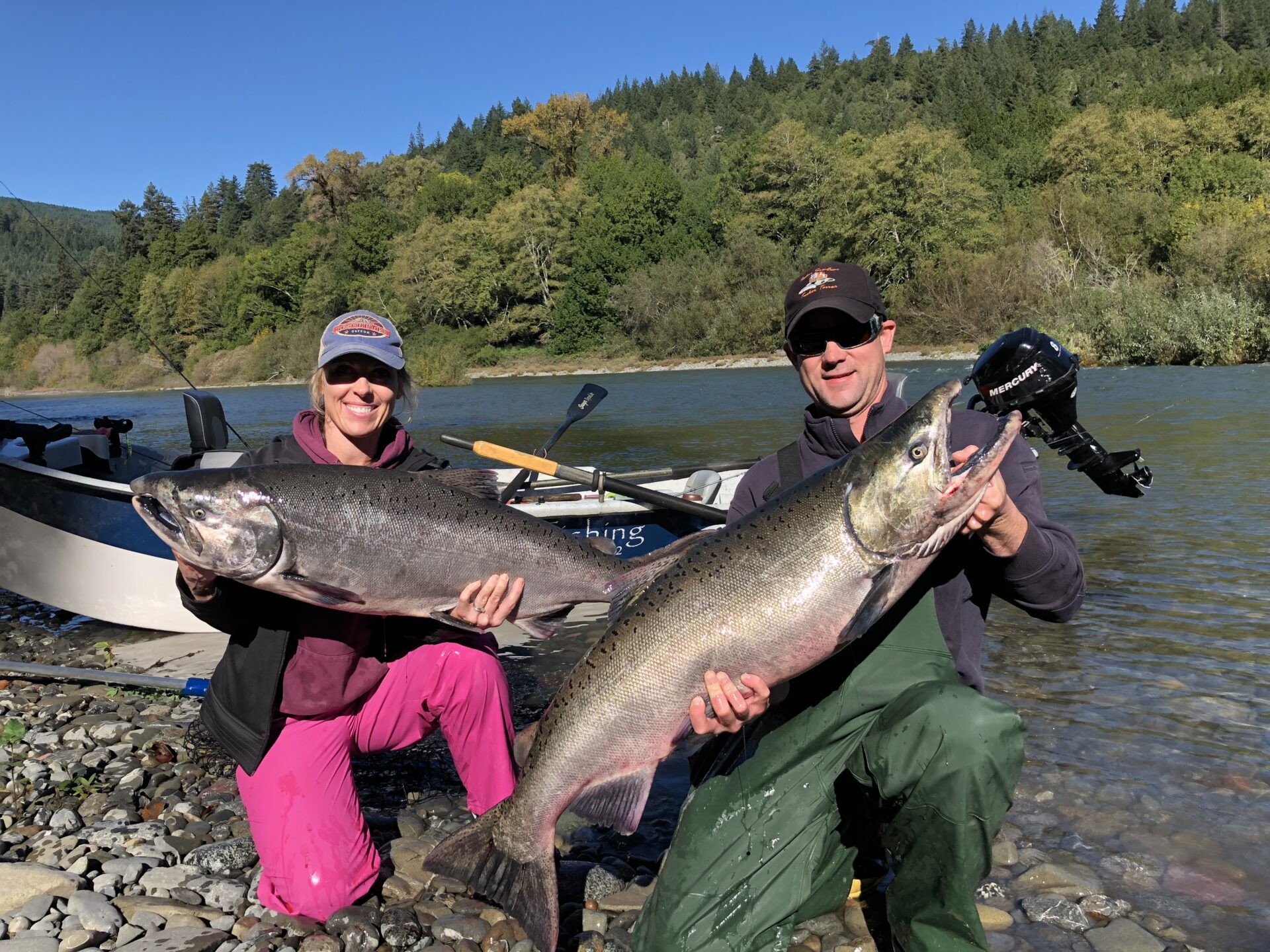Plugging Chetco River Salmon
By: Buzz Ramsey
If you crave big fall chinook, one that might tip the scales at 50 pounds or more, now would be a good time to plan a trip to Oregon’s Chetco River. Located on Oregon’s southern coast (near Brookings) the Chetco hosts a run of fall chinook that peaks in early to mid November, making it a destination for anglers from throughout the Northwest and beyond.

Jackie Howe of Bend, Ore., holds a Chetco River king that hit a 5.0 Mag Lip during the 2017 season while fishing with guide Andy Martin of Wild Rivers Fishing.
According to professional-fishing-guide Andy Martin of Wild Rivers Fishing, 206-388-8988, the majority of the salmon returning to the Chetco River consist of 4-year old chinook which average 20-to-25 pounds. However, twenty percent of each out-migrating year class of salmon return as 5-year old fish that average 35-to-40 pounds; with some bouncing the scale at 50 pounds or more. For example, while guiding clients on the Chetco River over the last dozen years Andy has netted at least one salmon at, approaching or above 50 pounds each and every season. His largest to date is a 65-pound monster taken during the later portion of the 2011 season.
Originating in the Siskiyou National Forest, the Chetco flows for 55 miles before reaching the Pacific Ocean. The Chetco is unlike many other Pacific Northwest rivers as there are no dams obstructing the salmons’ pathway to their spawning sanctuary.
The river hosts a strong, self-sustaining wild run of fall chinook that according to ODFW can number as high as 15,000 returning adults. In addition, the Department of Fish and Wildlife supplements the wild run with an additional 125,000 fingerling size chinook that are liberated in the lower river. Being of hatchery origin these fish are fin-clipped prior to release and tend to stage low in the river, where released, upon their return as adults.
The Chetco offers excellent access for bank anglers thanks to the City of Brookings and state of Oregon owning a large section of the lower river. Called Social Security Bar, this nearly two mile stretch offers free public access to bank-bound anglers that plunk Spin-N-Glo lures, sometimes in combination with bait, from shore when the river is running 3,500 CFS or higher, and drift and float fish for salmon when the water is lower.

Shannon Lemieux of Junction City, Ore., holds a 48-pound Chetco River king salmon that hit a HawgNose FlatFish during the 2018 season on the Chetco River while fishing with guide Andy Martin of Wild Rivers Fishing.
In addition, the Chetco offers drift boat anglers’ excellent access with several put-in and take-out sites available. The most popular drift is from Lobe Park to Social Security Bar, a 5-to-6 mile float, which according to Andy Martin contains about 15 deep salmon holes. The next launch site is a private, pay-to-play launch called Ice Box. There are two launch sites above Ice Box that are located within the National Forest and go by the name of Miller Bar and Nook Bar. Nook Bar is the upper most launch and marks the upper deadline for the keeping of salmon.
The two fishing methods that dominate the drift boat fishery include back-bouncing bait and back-trolling plugs. Salmon egg clusters rigged in combination with a Corky Drifter are what the back bouncing crowd use. According to Andy Martin, the most popular Corky colors on the Chetco include rocket-red and green-chartreuse. When the water is on the high side those bouncing bait will switch out their Corky for a Spin-N-Glo threaded on their leader above a bearing bead and baited hook. A selection of 1-1/2 to 4 ounce sinkers is what’s needed if you are planning to back-bounce bait on the Chetco.
The other popular fishing technique is to back-troll salmon plugs. According to Andy Martin, salmon size plugs work especially well on the Chetco and account for the majority of the giant salmon taken in his boat. The plugs Andy employs most often are the 4.0 through 5.0 sizes Mag Lip, size M-2 FlatFish, and 5.5 Hawg Nose FlatFish. When it comes to determining what size plug to choose, it’s all about the water conditions.
The Chetco, like other rivers up and down the coast, is heavily influenced by rainfall. It’s the onslaught of storms originating over the Pacific and later hitting the coast that causes rivers to rise and subsequently drop when the rain subsides. Salmon, smelling the fresh water, migrate into rivers from the ocean each time the rivers come up and bite best as water levels drop and clear from each rain storm. A big rain event can make the Chetco River unfishable and not clear enough to fish for four or five days. When the water first drops and clears is when the catching is at its best.

Jackie and Carl Howe of Bend, Ore., hold a pair of king salmon caught Oct. 23, 2017, on the Chetco River while fishing with guide Andy Martin of Wild Rivers Fishing. They were using 5.0 MagLip plugs.
According to Andy, the ideal height for the Chetco is 3,000 CFS (Cubic Feet per Second) and the river is considered low when it drops down to 1,200 CFS or less.
What Andy has learned over his many years of guiding is that he can catch salmon using plugs when the river is as high as 5,000 or at times even 6,000 CFS, providing the water is clear enough to see two feet or more into it. When the Chetco is dropping from a high water event, it’s the clarity of the water Andy closely watches.
This is a time when he employs the large salmon plugs that dive deep like the Hawg Nose or 5.0 size Mag Lip. The fast actions these plugs provide when back-trolled not only catch fish but their frantic action can shake the leaves off that strong winds can sometimes blow into the river. As the river continues to drop and clear, all the way down to 1,200 CFS, Andy reduces his plug sizes down to an M-2 size FlatFish and/or 4.0 size Mag Lip.
Although you can take your own drift boat, fully guided salmon fishing trips are available from guides should you decide to try your salmon luck from a boat. While the number of guides residing in Brooking is somewhat limited, this popular fishery draws professional guides from surrounding towns like Grants Pass, Medford and Gold Beach. There are several guides from California that work the Chetco too, so don’t limit your guide search to just the Brookings area.
The chinook limit on the Chetco is currently one salmon per day, and no more than five per year. Current regulations require you to stop fishing after catching your one adult salmon. And while your daily limit can include up to five jack salmon (salmon measuring between 15 and 24 inches) you must catch them prior to retaining an adult salmon.
Tackle, bait, shuttles, and fishing info can be obtained at Riverside Market, 541-661-3213, which is located along the lower Chetco near Social Security Bar.
